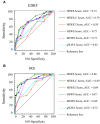Prognostic Accuracy of Early Warning Scores for Clinical Deterioration in Patients With COVID-19
- PMID: 33598468
- PMCID: PMC7882600
- DOI: 10.3389/fmed.2020.624255
Prognostic Accuracy of Early Warning Scores for Clinical Deterioration in Patients With COVID-19
Abstract
Background: Early Warning Scores (EWS), including the National Early Warning Score 2 (NEWS2) and Modified NEWS (NEWS-C), have been recommended for triage decision in patients with COVID-19. However, the effectiveness of these EWS in COVID-19 has not been fully validated. The study aimed to investigate the predictive value of EWS to detect clinical deterioration in patients with COVID-19. Methods: Between February 7, 2020 and February 17, 2020, patients confirmed with COVID-19 were screened for this study. The outcomes were early deterioration of respiratory function (EDRF) and need for intensive respiratory support (IRS) during the treatment process. The EDRF was defined as changes in the respiratory component of the sequential organ failure assessment (SOFA) score at day 3 (ΔSOFAresp = SOFA resp at day 3-SOFAresp on admission), in which the positive value reflects clinical deterioration. The IRS was defined as the use of high flow nasal cannula oxygen therapy, noninvasive or invasive mechanical ventilation. The performances of EWS including NEWS, NEWS 2, NEWS-C, Modified Early Warning Scores (MEWS), Hamilton Early Warning Scores (HEWS), and quick sepsis-related organ failure assessment (qSOFA) for predicting EDRF and IRS were compared using the area under the receiver operating characteristic curve (AUROC). Results: A total of 116 patients were included in this study. Of them, 27 patients (23.3%) developed EDRF and 24 patients (20.7%) required IRS. Among these EWS, NEWS-C was the most accurate scoring system for predicting EDRF [AUROC 0.79 (95% CI, 0.69-0.89)] and IRS [AUROC 0.89 (95% CI, 0.82-0.96)], while NEWS 2 had the lowest accuracy in predicting EDRF [AUROC 0.59 (95% CI, 0.46-0.720)] and IRS [AUROC 0.69 (95% CI, 0.57-0.81)]. A NEWS-C ≥ 9 had a sensitivity of 59.3% and a specificity of 85.4% for predicting EDRF. For predicting IRS, a NEWS-C ≥ 9 had a sensitivity of 75% and a specificity of 88%. Conclusions: The NEWS-C was the most accurate scoring system among common EWS to identify patients with COVID-19 at risk for EDRF and need for IRS. The NEWS-C could be recommended as an early triage tool for patients with COVID-19.
Keywords: COVID-19; NEWS; NEWS 2; NEWS-C; community-acquired pneumonia; early warning score; quick sequential organ failure assessment.
Copyright © 2021 Su, Ju, Xie, Yu, Zheng, Ma, Liu, Ma, Yu, Tu and Luo.
Conflict of interest statement
The authors declare that the research was conducted in the absence of any commercial or financial relationships that could be construed as a potential conflict of interest.
Figures


References
LinkOut - more resources
Full Text Sources
Other Literature Sources
Miscellaneous

